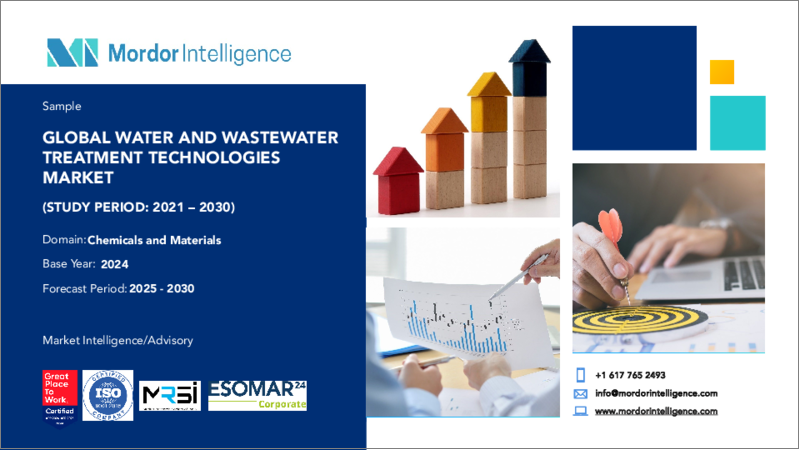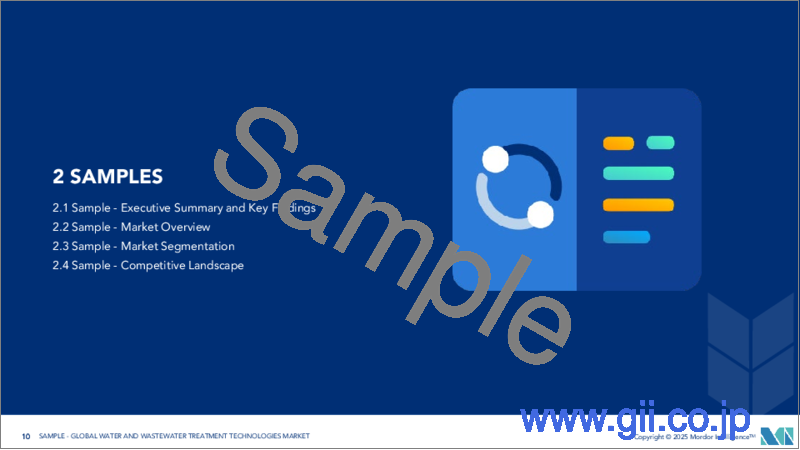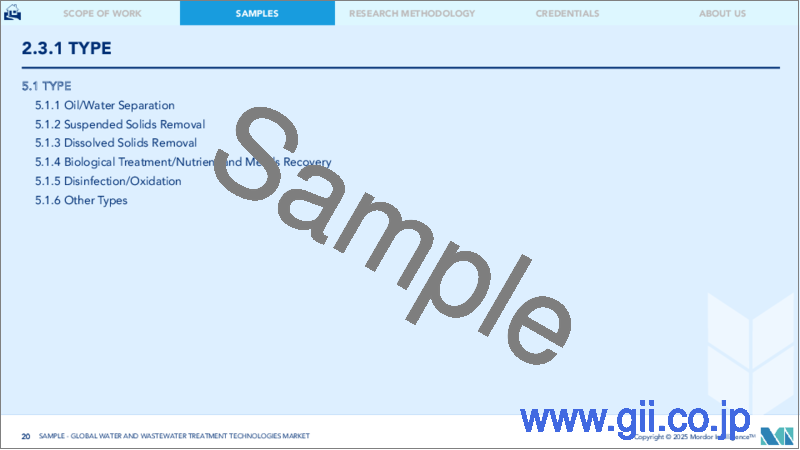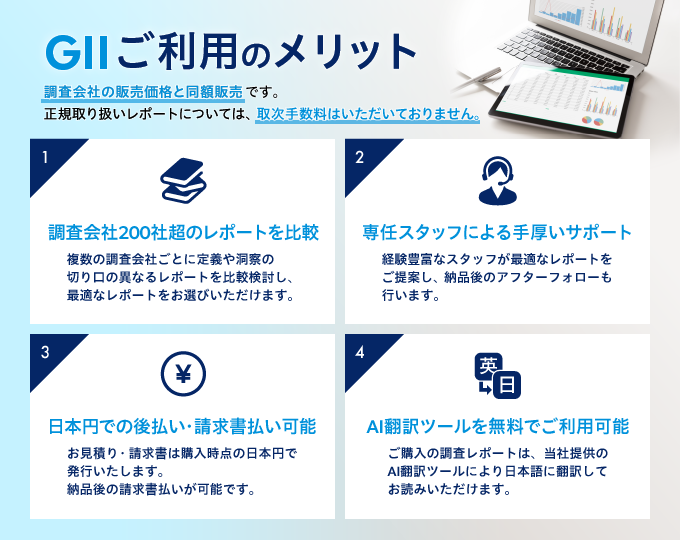|
|
市場調査レポート
商品コード
1640361
上下水道処理技術:市場シェア分析、産業動向と統計、成長予測(2025年~2030年)Water And Wastewater Treatment Technologies - Market Share Analysis, Industry Trends & Statistics, Growth Forecasts (2025 - 2030) |
||||||
カスタマイズ可能
適宜更新あり
|
|||||||
| 上下水道処理技術:市場シェア分析、産業動向と統計、成長予測(2025年~2030年) |
|
出版日: 2025年01月05日
発行: Mordor Intelligence
ページ情報: 英文 120 Pages
納期: 2~3営業日
|
全表示
- 概要
- 目次
上下水道処理技術市場規模は2025年に651億5,000万米ドルと推定され、2030年には871億8,000万米ドルに達すると予測され、予測期間中(2025~2030年)のCAGRは6%を超えると予測されます。
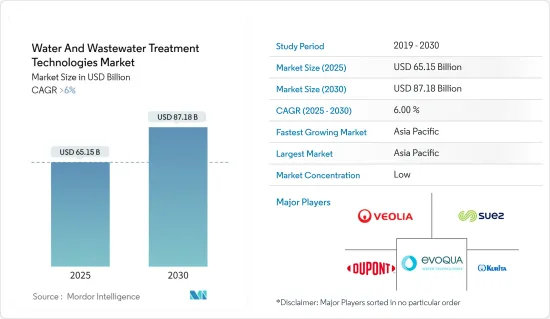
COVID-19パンデミックは市場にマイナスの影響を与えました。封鎖や制限により製造施設や工場が閉鎖されたためです。サプライチェーンと輸送の混乱はさらに市場に障害をもたらしました。しかし、2021年には産業は回復し、市場の需要は回復しました。
主要ハイライト
- 短期的には、世界的に淡水資源が急速に減少していること、シェールガス探鉱活動からの需要が増加していること、新興経済諸国における廃水処理の複雑さが増していることなどが、市場の成長を促す要因となっています。
- その反面、水処理プラントの高コストが市場成長の妨げになると予想されます。
- しかし、水処理技術の革新は市場にとって好機となると予想されます。
- 予測期間中、アジア太平洋が最も高い成長率を示すと考えられます。
上下水道処理技術の市場動向
上下水道処理セグメントが市場を独占する見込み
- 都市廃水とは、トイレ、シャワー、洗面台、浴室、洗濯機、食器洗浄機、液体産業廃棄物などから排出される水のことです。都市廃水は、環境へのダメージや有害な病気の蔓延を避けるため、環境に放出する前に処理されなければならないです。
- 処理技術の主要用途には、予備処理、一次処理、二次処理、三次処理、生物学的栄養塩除去(BNR)、資源回収、エネルギー生成などがあります。
- 中国の都市/都市地域には約1,944の都市廃水処理プラントがあり、中国の郡には1,599の都市廃水処理プラントがあります。1日の処理能力はそれぞれ1億4,000万m3、2,900万m3です。第14次5カ年計画(FYP)において、中国は廃水の再利用に関する新たなガイドラインを発表しました。このガイドラインでは、2025年までに再利用基準で処理しなければならない下水の割合を25%まで引き上げることを義務付けています。
- 政府のさまざまな取り組みにより、予測期間中、浄水は大幅に増加すると予想されます。エネルギー環境・水評議会(CEEW)は、2030年水資源グループにより、インドの廃水管理を改善し、廃水処理施設や原料を建設する水処理薬品製造会社への民間投資を増やす計画です。
- さらに、雨水処理エリア1西拡大プロジェクトでは、米国フロリダ州の2,509haの土地に水処理施設を建設し、1億7,000万米ドルを投資します。
- 廃水技術は、主にインド各都市の自治体当局による都市廃水処理に使用されています。世界銀行によると、インド、中国、インドネシア、ナイジェリア、米国は、2050年までに世界の都市人口急増の先頭に立つといわれています。
- さらに、国内の様々な自治体における自治体水処理は、より多くの農村部の人々が敷地内で安全かつ適切な飲料水を利用できるようにするための政府の取り組みにより、大幅な増加を観察しています。
- インド政府Jal Shakti省によると、2022年度には、敷地内で安全かつ十分な飲料水を利用できる農村人口の割合は、2021年度の55.23%から61.52%に増加しました。さらにインド政府は、2024年または2025年までに、敷地内で安全かつ十分な飲料水を全人口に100%供給することを目指しています。これにより、国内の自治体の水処理プラントが増強されることになります。
- イスラエルのIDE Technologiesは、アンドラ・プラデシュ州政府と手を組み、都市部の水不足を解消するため、各州に海水淡水化プラントを設置しました。
- 水不足を解消するため、エネルギー環境・水評議会(CEEW)は2030年水資源グループと共同で、インドにおける廃水管理を改善し、廃水処理プラントの建設への民間投資を増やすことを計画しています。
- 過去数年間で、インドの都市下水処理能力は大幅に増加しました。この処理能力の増大が、同国の革新的な水処理技術需要を牽引する可能性が高いです。
- したがって、上記の要因により、予測期間中、自治体の水、廃水処理技術が市場を独占する可能性が高いです。
アジア太平洋が市場を独占する可能性が高い
- アジア太平洋は、中国、インド、日本などの国々からの高い需要により、上下水道処理技術市場で大きなシェアを占めています。
- 中国は近年、産業廃水よりも多くの廃水を排出しています。この問題に拍車をかけているのが、特に国内の主要な工業地帯における巨大な汚染問題です。現在、中国の汚泥の80%は不適切に投棄されており、都市部では廃水処理施設(WWTP)を改善することで汚染を減らそうと躍起になっており、環境問題としてますます議論を呼んでいます。そのため、同国の上下水道処理技術市場には上向きの需要が見込まれます。
- 淡水の総取水量に占める化学製造用途の割合はかなり高いです。さらに、淡水不足の増大と様々な環境保護への取り組みが、都市廃棄物からのリサイクルと水の再利用を促進すると予想されます。
- 例えば、2022年6月、水環境管理に注力する環境保護企業China Everbright Waterは、山東省Zibo CityのZhangdianEast Chemical Industry Park工業廃水処理の拡大・改良プロジェクトを確保しました。このプロジェクトはBOT(Build-Operate-Transfer)モデルで運営され、1日当たりの工業廃水処理能力は約5,000m3と設計されています。
- 中国はまた、今後5年間で2,000万m3/日の廃水処理能力を追加建設すると発表しました。
- さらに、国際貿易局によると、中国は2021~2025年の間に、8万kmの下水収集パイプライン網を建設または改修し、下水処理能力を2,000万m3/日増加させる計画です。そのため、上下水道処理技術市場には上向きの需要が生まれます。
- 日本の下水普及率は約76%で、乾燥ベースで220万トン以上の下水汚泥が発生しています。下水汚泥は60~80%の有機物を含み、安定したエネルギー源となります。
- さらに日本の食品加工産業は、伝統的食品から加工食品まで、乳幼児から高齢者まで幅広い食品を生産しています。日本の食品加工産業は、飲食品製品の消費量の増加により、今後数年間で成長すると推定されます。包装食品に対する需要の高まりが、同国の飲食品産業を牽引しています。例えば、2022年3月、Domino's Japanは900店舗目をオープンしました。Domino's Pizza Enterprises Ltdの800号店開店から9ヵ月での達成は、Domino's Pizza市場初の快挙です。したがって、同国における飲食品産業の拡大は、同国の上下水道処理技術市場に上向きの需要を生み出すと予想されます。
- 以上の要因から、アジア太平洋は予測期間中、世界の上下水道処理技術市場を独占すると予想されます。
上下水道処理技術産業概要
上下水道処理技術市場は、その性質上、部分的にセグメント化されています。この市場の主要企業(順不同)には、Veolia、SUEZ、Evoqua Water Technologies LLC、DuPont、Kurita Water Industries Ltd.などが含まれます。
その他の特典
- エクセル形式の市場予測(ME)シート
- 3ヶ月間のアナリストサポート
目次
第1章 イントロダクション
- 調査の前提条件
- 調査範囲
第2章 調査手法
第3章 エグゼクティブサマリー
第4章 市場力学
- 促進要因
- 淡水資源の急速な減少
- シェールガス開発による需要の増加
- 新興経済諸国における廃水の複雑化
- 抑制要因
- 水処理技術の高コスト
- 水処理技術の適切な使用に関する認識不足
- 産業バリューチェーン分析
- ポーターのファイブフォース分析
- 供給企業の交渉力
- 買い手の交渉力
- 新規参入業者の脅威
- 代替品の脅威
- 競合の程度
第5章 市場セグメンテーション(金額ベース市場規模)
- タイプ
- 油水分離
- 浮遊固形物除去
- 溶解固形物除去
- 生物学的処理/栄養塩・金属回収
- 消毒/酸化
- その他
- エンドユーザー産業
- 地方自治体の上下水道処理
- 飲食品
- パルプ・製紙
- 石油・ガス
- 医療
- 養鶏・水産養殖
- 化学・石油化学
- その他
- 地域
- アジア太平洋
- 中国
- インド
- 日本
- 韓国
- ASEAN諸国
- その他のアジア太平洋
- 北米
- 米国
- カナダ
- メキシコ
- 欧州
- ドイツ
- フランス
- 英国
- イタリア
- その他の欧州
- 南米
- ブラジル
- アルゼンチン
- その他の南米
- 中東・アフリカ
- サウジアラビア
- 南アフリカ
- その他の中東・アフリカ
- アジア太平洋
第6章 競合情勢
- M&A、合弁事業、提携、協定
- 市場シェア(%)**/ランキング分析
- 主要企業の戦略
- 企業プロファイル
- AECOM
- Aquatech International LLC
- Black and Veatch Holding Company
- Doosan Heavy Industries and Construction
- DuPont
- Ecolab
- Evoqua Water Technologies LLC
- Hindustan Dorr-Oliver Ltd
- Hitachi, Ltd.
- ITT INC.
- Kurita Water Industries Ltd
- Mott MacDonald
- REMONDIS SE and Co. KG
- SLB
- Siemens
- SUEZ
- Thermax Limited
- VA Tech Wabag Ltd.
- Veolia
第7章 市場機会と今後の動向
- 水処理技術の革新
- グリーンケミカルズへのシフト
The Water And Wastewater Treatment Technologies Market size is estimated at USD 65.15 billion in 2025, and is expected to reach USD 87.18 billion by 2030, at a CAGR of greater than 6% during the forecast period (2025-2030).

The COVID-19 pandemic negatively impacted the market. It was because of the shutdown of the manufacturing facilities and plants due to the lockdown and restrictions. Supply chain and transportation disruptions further created hindrances for the market. However, the industry witnessed a recovery in 2021, thus rebounding the demand for the market studied.
Key Highlights
- Over the short term, rapidly diminishing freshwater resources worldwide, increasing demand from shale gas exploration activities, and growing wastewater complexities in developing economies are some factors driving the market's growth studied.
- On the flip side, the high cost of water treatment plants is expected to hinder the studied market's growth.
- However, innovations in water treatment technologies are anticipated to act as an opportunity for the market studied.
- Asia-Pacific is likely to witness the highest growth rate during the forecast period.
Water and Wastewater Treatment Technologies Market Trends
Municipal Water and Wastewater Treatment Segment is Expected to Dominate the Market
- Municipal wastewater is the water draining from toilets, showers, sinks, bathrooms, washing machines, dishwashers, and liquid industrial waste. Municipal wastewater should be treated before releasing it into the environment to avoid damage to the environment and the spreading of harmful diseases.
- The major applications of treatment technologies include preliminary treatment, primary and secondary treatment, tertiary treatment, biological nutrient removal (BNR), resource recovery, energy generation, and others.
- There are nearly 1,944 municipal wastewater treatment plants across China's city/urban regions and 1,599 municipal wastewater treatment plants across China's counties. It accounts for daily processing capacities of 140 and 29 million cubic meters, respectively. In the 14th five-year plan (FYP), China published new guidelines for wastewater reuse. It mandated raising the proportion of sewage that must be treated to reuse standards to 25% by 2025.
- Due to various government initiatives, water purification is expected to increase significantly during the forecast period. With the 2030 Water Resources Group, the Council on Energy, Environment, and Water (CEEW) plans to improve wastewater management in India and increase private investments in water treatment chemicals manufacturing companies to build wastewater treatment facilities and raw materials.
- Furthermore, Stormwater Treatment Area 1 West Expansion project involves the construction of water treatment facilities on 2,509ha of land in Florida, the United States, with an investment of USD 170 million.
- Wastewater technology is primarily used in municipal wastewater treatment by the municipal authority of various cities across India. According to the World Bank, India, China, Indonesia, Nigeria, and the United States will lead the world's urban population surge by 2050.
- Moreover, the municipal water treatment in various municipalities in the country is observing a significant increase owing to government initiatives to provide the more rural population access to safe and adequate drinking water within their premises.
- According to the Ministry of Jal Shakti of the Government of India, in FY 2022, the percentage of the rural population with access to safe and adequate drinking water within premises increased to 61.52% from 55.23% in FY2021. Furthermore, the Indian government aims to provide 100% of its population safe and adequate drinking water within premises by 2024 or 2025. It will boost the municipal water treatment plants in the country.
- IDE Technologies, an Israeli firm, joined hands with the government of Andhra Pradesh to set up desalination plants in various states to overcome the water scarcity in the cities.
- To fulfill water scarcity, the Council on Energy, Environment, and Water (CEEW), in association with the 2030 Water Resources Group, is planning to improve wastewater management in India and increase private investments in building wastewater treatment plants.
- Over the past few years, the urban sewage capacity in India grew significantly. This growing capacity will likely drive the country's innovative water treatment technology demand.
- Hence, owing to the abovementioned factors, municipal water, and wastewater treatment technologies will likely dominate the market during the forecast period.
Asia-Pacific is Likely to Dominate the Market
- Asia-Pacific accounted for the major share of the water and wastewater treatment technologies market due to high demand from countries like China, India, and Japan.
- China is discharging more wastewater than industrial wastewater in recent times. Adding to the issue is the huge pollution problem, especially in the major industrial locations of the country. Currently, 80% of sludge in China is improperly dumped, an increasingly controversial environmental issue with urban centers scrambling to decrease pollution by improving their wastewater treatment plants (WWTPs). Therefore, it is expected to create an upside demand for the country's water and wastewater treatment technologies market.
- Chemical manufacturing applications account for a considerable share of the total freshwater withdrawal. Furthermore, increasing scarcity of fresh water and various environmental initiatives are anticipated to boost recycling and water reuse from municipal waste.
- For instance, in June 2022, China Everbright Water, an environmental protection company that focuses on water environment management, secured the expansion and upgrading project of the ZhangdianEast Chemical Industry Park Industrial Wastewater Treatment in Zibo City, Shandong Province. This project will be operated on a BOT (Build-Operate-Transfer) model, with a designed daily industrial wastewater treatment capacity of around 5,000 m3.
- China also announced the construction of 20 million m3/d of additional wastewater treatment capacity over the next 5 years.
- Moreover, according to International Trade Administration, China plans to build or renovate 80,000 km of sewage collection pipeline networks and increase sewage treatment capacity by 20 million cubic meters/day between 2021 and 2025. Therefore, creating an upside demand for the water and wastewater treatment technologies market.
- The sewage penetration rate in Japan is ~76%, with the country generating more than 2.2 million tons of sewage sludge on a dry basis. Sewage sludge contains 60-80% organic matter and constitutes a stable energy source.
- Furthermore, the Japanese food processing industry produces a wide range of foods, from traditional to processed food, for infants and older people. The food processing industry in the country is estimated to grow in the coming years, owing to the higher consumption of food and beverage products. The rising demand for packaged food is driving the food and beverage industry in the country. For instance, in March 2022, Domino's Japan opened its 900th store. It is the first Domino's Pizza Enterprises Ltd market to reach the milestone nine months after opening the Company's 800th store. Therefore, the expansion of the food and beverage industry in the country is expected to create an upside demand for the water and wastewater treatment technologies market in the country.
- Based on the above factors, Asia-Pacific is expected to dominate the global water and wastewater treatment technologies market during the forecast period.
Water and Wastewater Treatment Technologies Industry Overview
The Water and Wastewater Treatment Technologies Market is partially fragmented in nature. The major players in this market (not in any particular order) include Veolia, SUEZ, Evoqua Water Technologies LLC, DuPont, and Kurita Water Industries Ltd., among others.
Additional Benefits:
- The market estimate (ME) sheet in Excel format
- 3 months of analyst support
TABLE OF CONTENTS
1 INTRODUCTION
- 1.1 Study Assumptions
- 1.2 Scope of the Study
2 RESEARCH METHODOLOGY
3 EXECUTIVE SUMMARY
4 MARKET DYNAMICS
- 4.1 Drivers
- 4.1.1 Rapidly Diminishing Freshwater Resources
- 4.1.2 Increasing Demand from Shale Gas Exploration Activities
- 4.1.3 Growing Wastewater Complexities in Developing Economies
- 4.2 Restraints
- 4.2.1 High Cost of Water Treatment Technology
- 4.2.2 Lack of Awareness on Appropriate Usage of Water Treatment Techniques
- 4.3 Industry Value Chain Analysis
- 4.4 Porter's Five Forces Analysis
- 4.4.1 Bargaining Power of Suppliers
- 4.4.2 Bargaining Power of Buyers
- 4.4.3 Threat of New Entrants
- 4.4.4 Threat of Substitute Products and Services
- 4.4.5 Degree of Competition
5 MARKET SEGMENTATION (Market Size in Value)
- 5.1 Type
- 5.1.1 Oil/Water Separation
- 5.1.2 Suspended Solids Removal
- 5.1.3 Dissolved Solids Removal
- 5.1.4 Biological Treatment/Nutrient and Metals Recovery
- 5.1.5 Disinfection/Oxidation
- 5.1.6 Other Types
- 5.2 End-user Industry
- 5.2.1 Municipal Water and Wastewater Treatment
- 5.2.2 Food and Beverage
- 5.2.3 Pulp and Paper
- 5.2.4 Oil and Gas
- 5.2.5 Healthcare
- 5.2.6 Poultry and Aquaculture
- 5.2.7 Chemical and Petrochemical
- 5.2.8 Other End-user Industries
- 5.3 Geography
- 5.3.1 Asia-Pacific
- 5.3.1.1 China
- 5.3.1.2 India
- 5.3.1.3 Japan
- 5.3.1.4 South Korea
- 5.3.1.5 ASEAN Countries
- 5.3.1.6 Rest of Asia-Pacific
- 5.3.2 North America
- 5.3.2.1 United States
- 5.3.2.2 Canada
- 5.3.2.3 Mexico
- 5.3.3 Europe
- 5.3.3.1 Germany
- 5.3.3.2 France
- 5.3.3.3 United Kingdom
- 5.3.3.4 Italy
- 5.3.3.5 Rest of Europe
- 5.3.4 South America
- 5.3.4.1 Brazil
- 5.3.4.2 Argentina
- 5.3.4.3 Rest of South America
- 5.3.5 Middle-East and Africa
- 5.3.5.1 Saudi Arabia
- 5.3.5.2 South Africa
- 5.3.5.3 Rest of Middle-East and Africa
- 5.3.1 Asia-Pacific
6 COMPETITIVE LANDSCAPE
- 6.1 Mergers and Acquisitions, Joint Ventures, Collaborations, and Agreements
- 6.2 Market Share(%)**/Ranking Analysis
- 6.3 Strategies Adopted by Leading Players
- 6.4 Company Profiles
- 6.4.1 AECOM
- 6.4.2 Aquatech International LLC
- 6.4.3 Black and Veatch Holding Company
- 6.4.4 Doosan Heavy Industries and Construction
- 6.4.5 DuPont
- 6.4.6 Ecolab
- 6.4.7 Evoqua Water Technologies LLC
- 6.4.8 Hindustan Dorr-Oliver Ltd
- 6.4.9 Hitachi, Ltd.
- 6.4.10 ITT INC.
- 6.4.11 Kurita Water Industries Ltd
- 6.4.12 Mott MacDonald
- 6.4.13 REMONDIS SE and Co. KG
- 6.4.14 SLB
- 6.4.15 Siemens
- 6.4.16 SUEZ
- 6.4.17 Thermax Limited
- 6.4.18 VA Tech Wabag Ltd.
- 6.4.19 Veolia
7 MARKET OPPORTUNITIES AND FUTURE TRENDS
- 7.1 Innovations in Water Treatment Technologies
- 7.2 Shifting Focus Toward Green Chemicals
